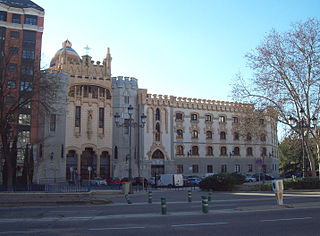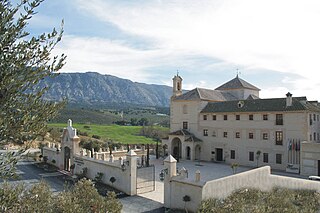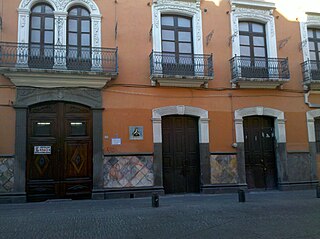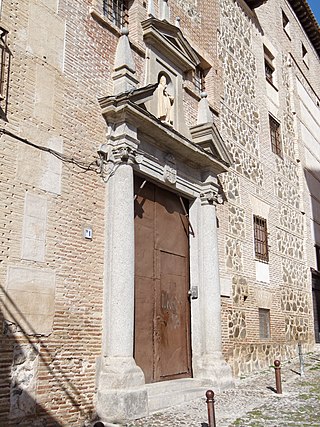
Rímac is a district in the Lima Province, Peru. It lies directly to the north of downtown Lima, to which it is connected by six bridges over the Rímac River. The district also borders the Independencia, San Martín de Porres, and San Juan de Lurigancho districts. Vestiges of Lima's colonial heyday remain today in an area of the Rímac district known as the Historic centre of Lima, which was declared a UNESCO World Heritage Site in 1988. Downtown Rímac District has, like its southern counterpart, its eastern and western sides divided by Jirón Trujillo, which connects to Lima District's Jirón de la Unión through the Puente de Piedra, the oldest bridge in the whole city. Rímac's East side features the Plaza de Acho, the most famous bullfighting arena in South America and one of the most well known in the world.
Antonio Fernández Arias was a Spanish painter of the Baroque period.

The Parish Church of Santa Teresa y San José, also known as the National Temple of Santa Teresa de Jesús and Convent of the Discalced Carmelite Fathers, is a Catholic church located in Madrid, Spain. The complex serves as a religious community residence, a nursing home and a parish church. It was declared Bien de Interés Cultural in 1995.

Convento de la Magdalena was a convent, now a hotel, situated to the southwest of the town of Antequera, Province of Málaga, Spain. Its history was known through the translation of an 18th-century monk's manuscript. In 2009 it was converted into a luxury hotel, known as the Hotel Convento La Magdalena, with 21 rooms. Olive groves and mills in the vicinity reflect the occupation of people in the area. A stream, Arroyo de la Magdalena, flows nearby.

Convent of Santa Fe is a former monastery situated in Toledo, Spain. It is situated in the north-east of the historic centre of the city. Included in the heritage listing Bien de Interés Cultural, it has been protected since 30 September 1919.

The Palacio Arzobispal de Toledo or Archbishop's Palace of Toledo is a palace located in front of the Cathedral and next to the City Hall in the city of Toledo, region of Castile-La Mancha, Spain.

The Discalced Carmelite convent of San José and Santa Teresa in Puebla traces its history back to its founding after the arrival in New Spain of Ana and Beatriz Núñez of Montealbán, sisters originally from Gibraleón in southern Spain. They had come to the New World to reunite with their brother Pedro Núñez, who died soon after their arrival in Veracruz. Beatriz married Juan Bautista Machorro, whereas her sister Ana remained at her sister's home in a sort of domestic cloister.

The Convento de Premonstratenses de San Norberto, also known as Convento de Mostenses or Convento de San Norberto, named after the founder of the Premonstratensian Order, is a religious building that disappeared. It was located on the ground of the current Plaza de Los Mostenses, next to the Gran Vía of Madrid (Spain). It was founded in 1611 by the community of the Fathers Canons Premonstratensians with the permission of Cardinal Archbishop of Toledo Bernardo de Rojas and financed by a benefactor, the Count of Miranda, Juan of Zúñiga, the then president of the Council of Castile. Today the site of the convent is occupied by a market built in the 19th century, known as Mercado de Los Mostenses.

The Convento de San José de los Carmelitas Descalzos was a convent located in the city of Zaragoza, that belonged to the Discalced Carmelites. It was demolished recently, in the 1970s.

The Convent of the Calced Augustinians is an Augustinian convent located in Toledo, Spain. The word calzadas translates to "calced" in English, referring to the fact that the community wore shoes, rather than going barefoot as other (stricter) religious orders did.

The Convento de San Clemente is a Renaissance convent located in the city of Toledo, in Castile-La Mancha, Spain. It was founded in the 13th century during the reign of Alfonso X of Castile the Wise. Inside the building there are a Roman cistern, Mudéjar architecture, remains of the Palacio de los Cervatos and many decorative elements.

The Convento de San Juan de la Penitencia, also known as the Colegio de Doncellas pobres de San Juan de la Penitencia, is an Isabelline former convent building that was erected in 1514 in Toledo, Spain.

The Agustinas Ermitañas Convento Santa Úrsula is an Augustinian convent located in the city of Toledo, in Castile-La Mancha, Spain. It was founded in 1259.

The Convento de la Madre de Dios is a Dominican convent located in the city of Toledo. It was founded at the end of the 15th century as a nunnery by Leonor and María de Silva, daughters of the Count of Cifuentes. It was a cloistered monastery, a Guardia Civil barracks, and finally a university campus after its acquisition by the University of Castilla-La Mancha to expand the facilities of the Faculty of Juridical and Social Sciences.

The Convento de las Carmelitas Descalzas de San José of Toledo is a monastic building dating from the second half of the 16th century.

The Convento de San Antonio de Padua is a Franciscan convent located in Toledo, Castile-La Mancha, Spain. Dedicated to St Anthony of Padua, the institution was created in 1525 in the former palace of the advisor comunero Don Fernando de Ávalos, confiscated by order of Charles V, Holy Roman Emperor because its owner was a comunero. The entrance is Gothic-Mudéjar of the 15th century.

The Convento de Santa Clara la Real is a convent of the Poor Clares located in the city of Toledo, Castile-La Mancha, Spain. The present convent was founded in the middle of the 14th century by Toledan noblewoman María Meléndez, and is located near other monasteries of note, such as the monastery of Santo Domingo el Real and the Convent of Capuchins of Toledo.

The Convento de San Pedro Mártir is a convent located in Toledo, Spain. The Dominican convent was moved in 1407 from its location outside the walls to the houses donated by Doña Guiomar de Meneses. through its successive extensions and modifications, became one of the richest and most important convents of the city.

The Convento de la Purísima Concepción, also called Convento de Capuchinas, is a convent located in the city of Toledo, in Castile-La Mancha, Spain.

The Our Lady of the Angels Convent, commonly known as the Iglesia y Convento de los Descalzos, is a Franciscan convent in Rímac District, Lima, Peru. It was declared a Cultural heritage of Peru in 1972.





















